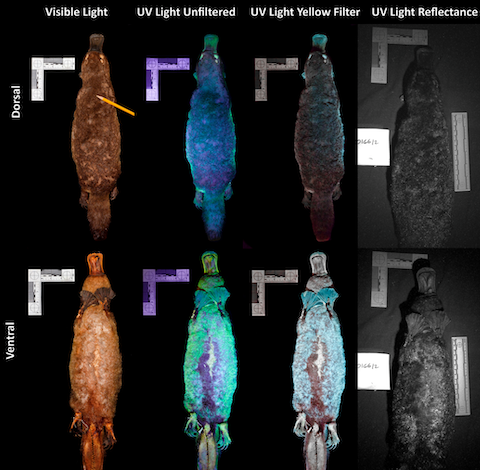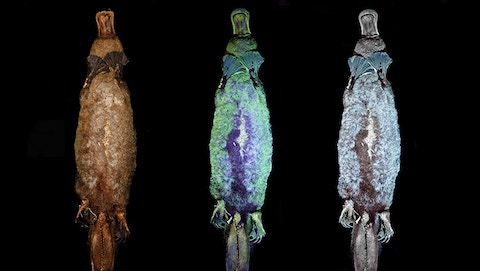
We’ve talked about some weird animals on EarthDate, but the platypus may be the strangest.
They’re famous for having a duckbill and a beaver tail. But that’s just the start of it.
Platypuses are monotremes, one of just three mammals—all in Australia—that lay eggs. But they also produce milk to nurse their young once hatched.
And they’re one of the few venomous mammals. Males have sharp spurs on their back legs that can inject poison potent enough to send a human to the hospital.
They spend much of their time underwater at night, making over a thousand short dives in a 24-hour period, hunting worms, crayfish, and water insects.
They close their eyes, ears, and nostrils underwater, so they rely on their bill to navigate. It has two types of electroreceptors, using direct current to avoid large objects when swimming and alternating current to detect the muscle activity of their prey.
They then zero in, using sensitive pressure receptors that can detect tiny movements in the water—less than the thickness of a human hair.
Their hips are splayed like a reptile’s. Their fur fluoresces under UV light like some marsupials. Their eyeballs are wrapped in cartilage like a bird but shaped like those of other water mammals. And their gene code shows ancestry from each of these animal groups!
Of course, all this weirdness is in the eye, or the bill, of the beholder. To a platypus, we furless bipeds may be the truly odd ducks.
Background
Synopsis: One of Earth’s strangest creatures is even stranger than we thought! The platypus has a furry body like an otter, a flat tail like beaver, and a bill and webbed feet like a duck. Platypuses hunt using electroreception and sport venomous talons on their back feet. They are mammals that lay eggs, but they nurse their young. The first time European naturalists examined a specimen of this native Australian creature, they thought it was a sewn-together hoax. And now we know the platypus fluoresces bright blue green in ultraviolet light, too. What a strange duck(bill)!
- The platypus is native to eastern Australia and Tasmania.
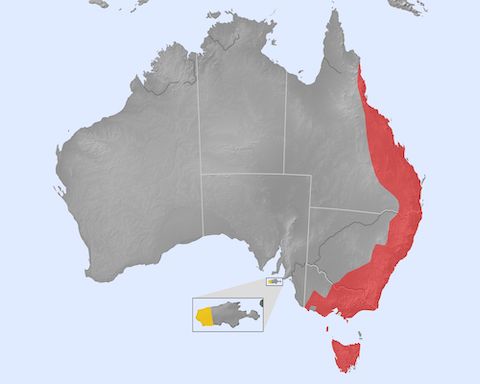
- This nocturnal hunter lives in freshwater habitats ranging from sea level at the coast into the Australian Alps at elevations of more than a mile (1600 m).
- The commonly used plural of “platypus” is “platypuses.” “Platypi” or “platypodes” are technically correct, but rarely used.
- Platypuses mature at the age of 2 years and can live as long as 25 years.
- Mature animals weigh about 3 lb (1.4 kg) and tend to be about 15 inches (38 cm) from head to rump with a 5-inch (13 cm) tail.

- The platypus is one of only five remaining species of monotremes: mammals that lay eggs but nurse their hatchlings.
- There are only three different types of mammals: placentals like us, marsupials with pouches like kangaroos, and egg-laying monotremes.
- Monotremes split from other mammals approximately 166 million years ago in the mid-Jurassic period. The platypus (Ornithorhynchus anatinus) is the last living species of its family and genus.
- The other four living species of monotremes are all echidnas (spiny anteaters), and are also indigenous to Australia.
- Monotreme means “single hole” in Greek. Everything that comes out of a monotreme, including eggs, leaves via the same hole.
- Monotremes never evolved the capability of live birth. Platypus females burrow into riverbanks and lay clutches of just 1–3 leathery eggs.
- The eggs are about 5/8 inches (16 mm) long and they incubate for about 10 days. When they hatch, the tiny young are helpless and must be cared for in their burrow for several months before they can start swimming.
- As mammals, platypus females have two round patches of mammary glands on their skin (like areolas) that, when rubbed, ooze milk for their hatchlings, but they don’t have nipples.
- Since all mammals produce milk, the ability to nurse young must have developed in ancestral mammals before the Jurassic split occurred 166 million years ago.
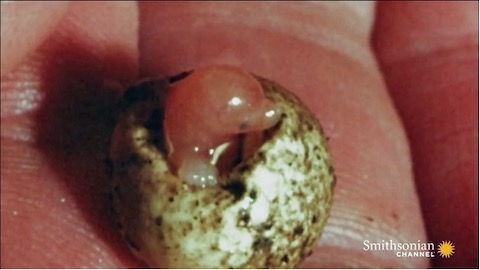
- The most obvious odd feature of the platypus is its unique “duck bill,” which has amazing sensing superpowers!
- On the skin of the bill, in rows, there are thousands of electrical receptors that help the platypus to use direct current to locate and avoid objects while swimming in the dark, and alternating current to help detect the muscle activity of its prey (usually aquatic invertebrates).
- At the same time, mechanical receptors are distributed all over the bill, providing a highly sensitive pressure sense that can sense a water displacement of just 20 microns.
- The platypus moves its head back and forth, using the combination of electroreception and mechanoreception to sense the distance and direction of its prey, even while its eyes, ears, and nose are all closed underwater.
- Though platypuses seem like they are made for water, they can only remain underwater for 30 to 140 seconds before having to come up for air.
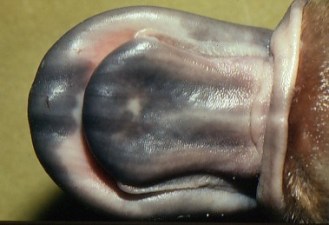
- The platypus tail is unusual because it is furry, flat, and wide.
- The platypus uses it, along with their back feet, as a rudder while swimming.
- Females press it against their belly to carry grasses for nest building and to keep their eggs warm during incubation.
- In case of food shortages, the tail stores nearly half the creature’s body fat.
- Platypuses have webbed feet and move much better in water than on land.
- On land, the webbing between their front claws retracts, and they walk clumsily on their knuckles to protect it.
- They have to expend 30% more energy than a similarly sized land animal to move around when out of water.
- In water, they paddle with their front feet and steer with their back feet and tail.
- There aren’t many venomous mammals, but platypus males have venomous spurs on their back feet, so watch out during mating season!
- Other venomous mammals include some moles, shrews, and bats that use venom to immobilize prey.
- The venom produced by platypus males is similar to reptile venom and is most concentrated during mating season.
- It can cause swelling and excruciating pain in humans and is said to be potent enough to kill a dog.
- The venom spurs are like spurs found in archaic mammal fossils and are thought to be a characteristic of ancient mammals. Platypuses seem to be the only mammals that have retained these talons.
- The platypus is also unique among mammals for its eyes: like birds, reptiles, amphibians, and sharks, their eyeballs are enclosed in cartilage.
- The back of the platypus’s eyeball is curved, whereas the lens is flat, like the eyes of otters and sea lions. This improves underwater vision.
- The eye has a ratio of rods to cones similar to mammals, but also double retinal cone cells, like reptiles.
- Like other monotremes, platypuses don’t have stomachs.
- Platypuses have to breathe air, but they can only feed in freshwater, searching for small invertebrates under banks and submerged debris. As carnivores, they don’t eat plants.
- They store prey in their cheek pouches during brief dives, then surface to thoroughly grind the food at the back of their jaws, swallowing before diving again. They may make up to 1600 dives in a single 8-to-16-hour foraging session each night (they sleep during the day).
- Like about 25% of fishes, the platypus (and their monotreme cousins the echidnas) have a gullet that connects directly to their intestines—they don’t have a digestive acid-producing stomach. Platypuses eat constant small amounts when feeding, so they don’t need the holding capacity of a stomach.
- However, as warm-blooded mammals, males need to consume the equivalent of 15–28% of their bodyweight every day. Females may need to consume up to three times that much—80% of their body mass—when nursing young.
- All mammals have hair, and as warm-blooded mammals, platypuses have thick waterproof fur that traps insulating air pockets to protect them from the cold and help keep them buoyant in the water. And even their fur is special—recent research has shown it is biofluorescent!
- Biofluorescence occurs when living material absorbs ultraviolet light and emits a fluorescent glow at a different wavelength that is visible to humans. This glow may appear red, orange, green, or blue.
- It occurs in some fish, amphibians, reptiles, phytoplankton, and fungi, but it is only known to occur in a few types of mammals: opossums, flying squirrels, marsupials… and now the platypus.
- After their discovery of pink biofluorescence in flying squirrels, researchers from Wisconsin’s Northland College checked the effect on marsupials in the mammal collection at the Field Museum in Chicago. The platypus collection was in the next drawer, and when they opened it, the pelts glowed bright fluorescent green and blue.
- Other researchers had just reported biofluorescence in Australia of a recent platypus roadkill victim. The Northland College scientists found the same effect when they checked additional specimens at a museum in Nebraska.
- Now Australian biologists plan to check it out on live animals in the wild.
- Most of the odd traits that platypuses exhibit can be rationalized, but the biofluorescence attribute is still a mystery. What is its purpose?
- Many animals have cones in their eyes that enable them to see ultraviolet light, which is not visible to humans.
- Most animals with biofluorescence are active at night or during the low light of dawn or dusk, so the glow is thought to have something to do with the dark, but nocturnal platypuses swim with their eyes closed.
- Could it be a way to camouflage them from nocturnal predators that can see UV light (like large fish, raptors, and dingos), by absorbing some UV light to become less obvious?
- Is it a way for solitary animals to spot each other in the dark?
- Or, like some of the other archaic characteristics that platypuses have retained, is biofluorescence yet another trait that was common in our mammal ancestors?
